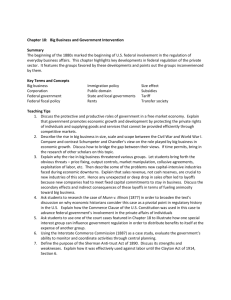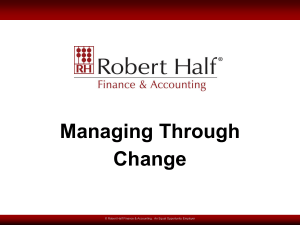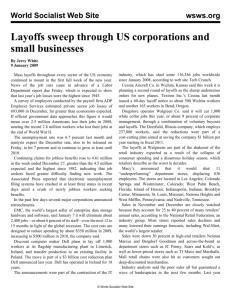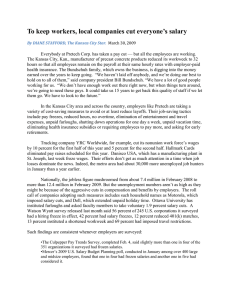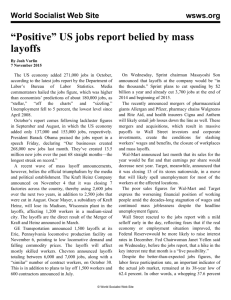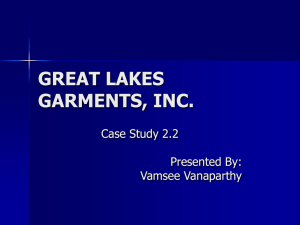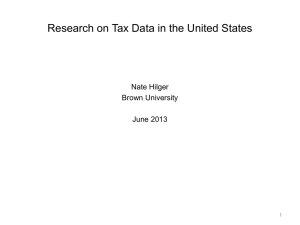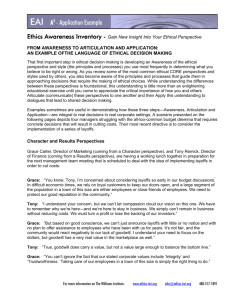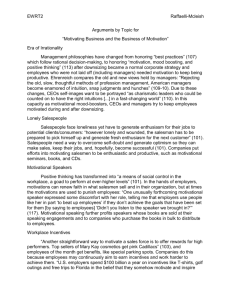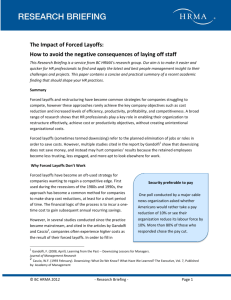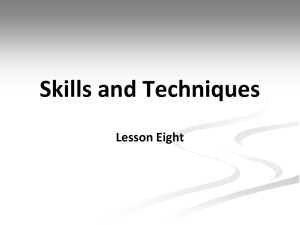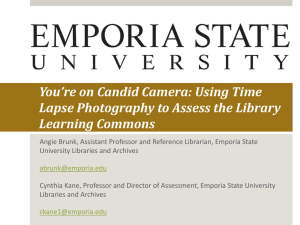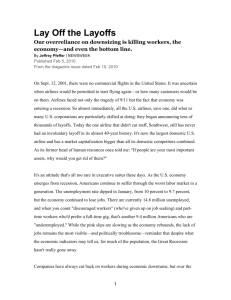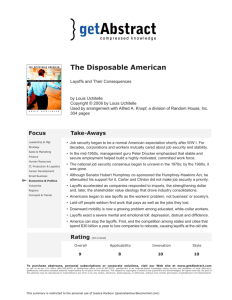SLA Presentation.ppt
advertisement
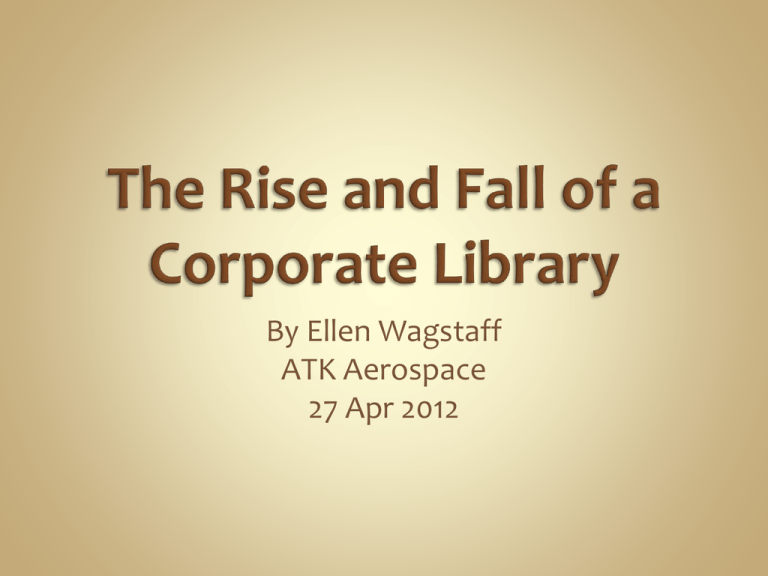
By Ellen Wagstaff ATK Aerospace 27 Apr 2012 Companies go through cycles and repeat them as time goes on. I have been through them all and repeated several in 27 years. Growing – increase the amount of business currently generated Stabilizing – maintain or slightly improve the amount of business generated Retrenchment – management attempts to protect the amount of business being generated Downsizing or divestiture – strategy to eliminate a SBU that is not generating a satisfactory amount of business and has little hope of doing so in the future Thiokol (ATK)Library started in 1960 First librarian was an engineer with no library background— he started straight out of college and was given the responsibility to organize the engineering collection of books and papers. Started his own numbering system for technical reports, which is still in use today Developed a new way to classify documents by subject—it involved tiers and large subsets—it was very involved and not user friendly No computers Everything done by hand—typewriters We had a copier that was designated for “Library Use Only,” which was great. There were only a few copiers in the building. Management style was regimented—very “military” oriented Staff numbered eight and sat lined up in desks like “ducks in a row” Company policy dictated that any book, magazine, report, etc. had to be approved by and ordered through the Library. This gave us a great deal of clout but created a bottleneck. Added access to OCLC and started doing interlibrary loans Computers were moved into the library—with Bernoulli tapes for backup Six months after I was hired, the Challenger accident occurred and layoffs started. A freeze on budgets was in place for 18 months. The shuttle redesign brought new work and an infusion of money from NASA . The library grew like crazy. Went electronic with specs and standards Added more periodicals Weeded and upgraded the collection Remodeled the library—went from gray linoleum to blue carpet and matching tables and chairs We went through several management changes and were moved from organization to organization. HR Training and Development Engineering Publications—where we still report today Our new boss knew nothing about libraries but was willing to learn and listen to us. His management style was very team oriented. It made all the difference. The Publications department had the skills and resources necessary to help us start marketing in a big way. Survey of users Service/comment sheet sent out with each filled request Brochures Handout in the new hire orientation booklets Bookmarks Open house when library remodeled Hosted ULA one month and had a tour and luncheon Started a column in the weekly company newsletter What new books were available—this one backfired—we offered new books on furthering your career and older management types complained Over the next 20 years, the company did well financially and our budget grew. Added companywide electronic access to specs and standards Moved library to a larger area As employees retired, they were replaced with computers. We were able to keep services at the same levels as before Less paper but more electronic records Library was moved again to a larger location. We had 8 study cubicles, a sofa in the reading area, a TV / VCR to preview safety videos, and a Wi-Fi connection Interlibrary loans were great but we cut back on periodicals due to space, money, and the demand for a larger range of titles. This meant a cut in our budget. As collections went online, we no longer were required to keep hard copies. This meant a loss of users and foot traffic Policies/procedures In-plant handling manual Specs and standards New hire orientation moved to online so our brochures turned into a blurb about library services instead of a handout they could keep. Major downfall was the loss of our core clientele. With the loss of the Space Shuttle contract, massive layoffs started four years ago. We have gone from 7,000 to 1,500 employees. With no new money coming in, R&D was hit hard and many of the engineers left. This was our core clientele. Overhead budgets were cut to the bone. The library department has always been an overhead department . Unable to charge to other divisions—as engineers transferred to other divisions, they still wanted us to do searches and order ILLs for them. Because our accounting system is not set up to do interdivisional charging, I am unable to help them even though I have the time and expertise. Downsizing - facilities were closed and people moved tighter together. We lost valuable floor space. Transfer of more responsibilities to you without an increase in your budget, i.e., safety video collection Kingdom building—other departments start to horde materials and develop their own collections trying to show they have value as a group. This leads to duplicate efforts and money wasted. Eventually it all ends up with you anyway. Services are dropped because there is not enough manpower to continue to do the job or do it thoroughly. Lots of information and resources fall through the cracks and are lost. At this point, marketing doesn’t help – everyone is struggling to stay afloat and keep their employees. Search skills – New engineers come out of college knowing how to use Google but they don’t have the expertise, the breadth of knowledge, or the resources to do good research. Archives – I took over the archives in the early ’90s and learned to write retention schedules. Organizations are required to keep their records for legal, fiscal, and historical reasons. This is a needed position and dovetails nicely with my library background. I have become a one-person library. I am an on-demand library now. I order as items are requested. Because I have all the accounts and systems already in place, I am considered a “valued” employee. Because my department was hit hard, I had more jobs added. Unofficial company historian Bottom line is $$$ and ROI Can you show you add value to the company? Tangible results Benchmarking Align with highest management level you can No more than two steps below VP Attend department meetings at highest level you can—gives you an insight to where the company is going and what projects they are pursuing—this gives you a heads up on where to focus Overhead is deadly Charge back to specific projects—don’t charge to overhead if you can help it Have a champion—someone who will fight for you and your services The more the better—realignments, layoffs, etc. can occur any time Network within the company—and keep those connections even when they no longer work for the company. Don’t become complacent. Things change overnight— literally. Expect change and be flexible Thiokol has been sold or merged five times in the 27 years I have worked there. Each company had its own culture, vision, and mission statement. Some put emphasis on the library, others didn’t. Management styles changed. ALWAYS be prepared to advance or move—NEVER say “It won’t happen to me” Network, network, network Keep your resume up to date Add to your skill set Keep up to date on newest trends in electronics and information, new software Consider outsourcing your services to your company Browse through current job openings to see what requirements, certifications, job experience, etc. are being called for. This gives you an idea of where you can improve. Consider a horizontal job move Competitive intelligence Records management/archives Records management/library services often combined Find a niche Hone your search skills—users can Google and wiki search but to really do an in-depth search, they don’t have the tools or resources More companies moving to EDMS systems: Become an expert on metadata and how to data map— information is not usable in any format if it’s not indexed correctly Read monthly editorials in Info Tech by Stephan Abrams or his blog, Stephen’s Lighthouse Don’t put yourself in a box—when jobs are few there is a fine line between professional and clerical—you may end up doing both. Be flexible—be willing to pick up additional responsibilities Job depth – adding tasks that require a wider range of skills usually including autonomy Job scope – number of different activities required in a job and the frequency each activity is performed Job enlargement – adding more similar tasks IT services – IT doesn’t understand user’s need Become a liaison between user, vendor, IT Procurement/password/security control for services—especially important when layoffs occur Copyright expert on electronic media—how many copies can be kept, can you email outside the company Keep your memberships up to date Volunteer for local leadership positions within SLA, ULA Get involved—get your name recognized Volunteer for the company Family Day, 5K runs, Science Fair judging, help plan the department Christmas party, etc. Volunteer outside the company – Scouts, church, professional
